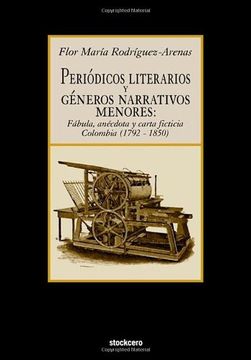Periodicos Literarios y Generos Narrativos Menores: Fabula, Anecdota y Carta Ficticia Colombia (1792- 1850)
Reseña del libro "Periodicos Literarios y Generos Narrativos Menores: Fabula, Anecdota y Carta Ficticia Colombia (1792- 1850)"
The early nineteenth century Colombian fiction narrative lacked until now of an in depth critical study, as most histories of Colombian literature while discussing the period between 1825 and 1850 limit their focus on newspaper texts with costumbrista tendencies, neglecting the rich different variations of fiction written during that time. With the detailed and careful study of the first five literary newspapers published between 1825 and 1850 en Colombia: La Miscelanea (1825-1826), La Estrella Nacional (1836), El Albor Literario (1846), El Duende (1846-1849), El Museo (1849), and texts from: El Reconciliador Bogotano (may-july, 1827), El Cachaco de Bogota (1833), and El Dia (1840-1851), prof. Flor Maria Rodriguez-Arenas offers a panorama of the complex evolutionary process of the narrative of fiction in Colombia during the early nineteenth century. During the first half of the 19th century, Colombia produced a diversity of fiction writings published in newspapers, magazines and books. These simple structured texts reveal the change in thought that emerged along those decades, while underlining the influence of the orality still prevalent in the area. A great number of the period's narrative texts tend to develop several lines of argument at the same time, while incorporating techniques and topics of journalism, bits of poetry and traces of popular culture. In some of the genres found during those years, the storyteller tends to overwhelm the story. Indirectly, this kind of testimonial overkill illustrates the problematic relationship of the speaker with the main line of the story. In other instances, the narrative texts depict a curious enactment of experiences which offset their fictition status; and in some cases they resemble an essay rather than a well-structured story. In this trajectory that leads to the novel, there are simple narrative forms such as: 1) The fable, in prose or verse, that had been a favorite literary form since Classical times, now aimed to critique, and often satirize, the social political circumstances. 2) The anecdote: tales that reveal aspects of the emerging social and cultural changes. 3) The fictitious letter, a short narrative form that was more sophisticated and included thematic consciousness and expressive intensity. These relatively simple and uncomplicated narrative forms lead to and later accompanied the genres of the short story, and the novel. The literary newspapers and the narrative texts of the period in question exhibit literary influences and special techniques that require careful study. "Periodicos literarios y generos narrativos menores: fabula, anecdota y carta ficticia Colombia (1792- 1850)" by prof. Flor Maria Rodriguez-Arenas provides the understanding of this initial period, so vital to assess the mass appeal of the novel that began in Colombia after 1850, and continues to the present.

